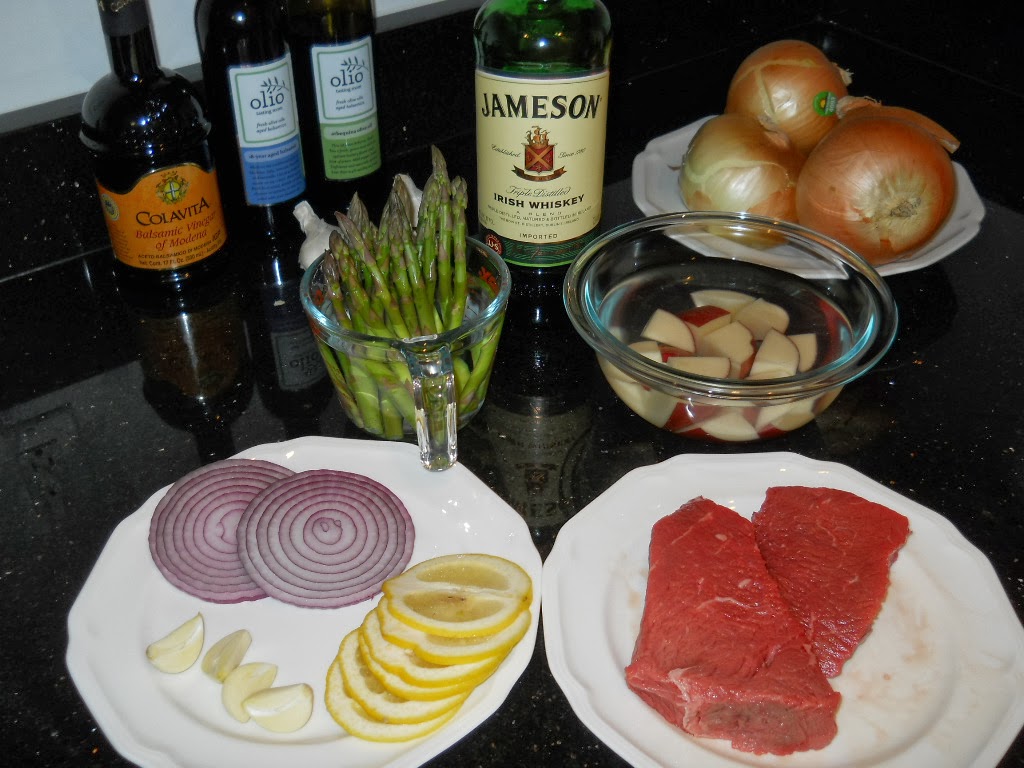 |
| Steak au Poivre Vert |
Steak au Poivre Vert
Steaks are chiefly used for romantic endeavours. Whether this is because steaks are red and red is the colour of love or because steaks are simply good tasting, is unknown. The basic practice of cooking a steak is to sear each side once and cook the steak no more than medium. The pan is then deglazed with brandy or whiskey which forms the basis of the sauce. Serve with asparagus and mashed potato.
Mise en Place
- 2 steaks, about 1/5 to 1/4 lb apiece
- 4 Tb of butter
- 2 Tb of olive oil
- 1/2 lb of asparagus spears
- 1/2 a red onion
- 2 cloves of garlic
- 3 red potatoes
- 1/4 cup whiskey or brandy
- 1/4 cup beef stock
- 1/2 cup heavy cream
- 1 tsp green peppercorns
- 1/2 tsp tarragon
Since the cooking time of the steak and sauce is short, it is necessary to have all things in place before beginning the cooking. Have the potatoes soaking in
cool water. Have the onions, lemon, and garlic, sliced. Have the steaks at room temperature and lightly coated with pepper. The asparagus should be soaking stem-down in cool sugar water for at least an hour.
Potatoes:
Boil water for the potatoes, they will cook for 20 mins. Set aside 1 T of butter and 1/4 cup of milk for mashing into the potatoes once they are boiled.
Steaks:
 |
| searing steak |
Heat a cask iron skilled until the surface just begins to smoke, then turn down the heat to medium or medium low. Add a pat of butter and lay the steaks down in the middle of the pan. Use only enough butter to cook with, any extra simply create more smoke and splatter. Cook until the blood beads on the surface then turn steaks and add more butter if necessary. Once turned, cook the steaks only for 3-5 mins more. Remove the
steaks from the pan and cover them in a warm place until ready to plate.
Asparagus:
Heat 2 T of butter and 1 T of olive oil in a skillet until hot. Add the asparagus and cook until they turn dark green. Add lemon and a splash of white wine and remove from the heat and cover. Keep warm until ready to plate.
Onions:
Once the steak is r
emoved, add more butter if necessary and add the onions and garlic quarters. Blacken the onions on each side and remove from pan with the garlic.
Sauce:
 |
| sauce with cream |
|
Once steak, onions, and garlic have been seared in the pan, add 1/4 cup of brandy or whiskey. Remove the pan from the heat and flame. Return the pan to heat (obviously once the flames have died) and add 1/4 cup of beef stock. Bring the liquid to a simmer. Then add 1 tsp of green peppercorns and 1/2 tsp of tarragon. Stir in and simmer for a moment. Add 1/2 cup of heavy cream and gradually stir it in. Gently bring the sauce back to a simmer. Stir often. Once the sauce is thickened, start squeezing a lemon slice into the pan and stir constantly. The lemon will emulsify the sauce if added slowly enough, if added to quickly the cream will curdle. Once the sauce emulsifies, remove from the heat and begin to plate the dishes.
 |
| emulsified sauce |
Plating:
Place a steak in the middle of each plate. Surround with asparagus. Add the onion rings. Cover the steak with sauce. Garnish with lemon and parsley.
Wine:
Drink a strong red, cabernet sauvignon will work. But for something new, try a nebbiolo d'alba. It is an Italian wine usually made from 100% nebbiolo graps, the same that go into a Barolo, but much more inexpensive since the region is different. Most styles spend at least a year on oak and are very enjoyable. Shoot for a wine that is around two years old. (So in 2013, drink a 2011 etc.) The wine will then have a year on oak to absorb flavour and a year in the bottle to sort the flavours out. Also, don't buy the bottle of wine the same day you plan on drinking it, buy it the week before, so it is not all shaken up.
Note on Dining-in:
The ingredients consumed in this meal tally to around $20 of mortal money. When a moderately priced wine is added, the total for two is around $35. If the table is set nicely and some inexpensive candles are lit, an entire evening can be had for less than $40 with a dinner for two. Now considering that the primary reasons for eating a restaurant are either one likes to have candles lit during dinner or one doesn't like doing dishes after dinner, one must think things over. If one lights a couple 5 cent candles at home, problem solved--a restaurant dinner for $40. If one absolutely won't do the dishes or clean as they go, then they can save at least $60 by eating at home and cleaning in the morning. Just some food for thought.
 |
| At table |
|
 |
| Plated | |






